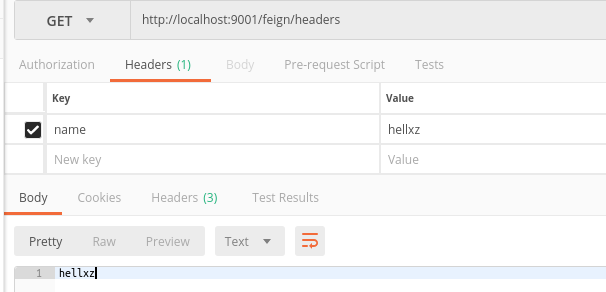Spring Cloud(十一)声名式服务调用:Feign的使用 (上)
一、写在前边
最近开发任务比较忙,下班也开始锻炼了,这个系列的文章就放了很久,看github我提交的Feign的入门程序已经好久了,今天正好得空,这就更上一贴,准备分几部分写
注意:之前几个项目中,笔者忽略了一个问题,pom文件中如果parent节点下的是spring-cloud-starter-parent而不是spring-boot-starter-parent的话,这样就可以不用写如下代码了
<dependencyManagement>
<dependencies>
<dependency>
<groupId>org.springframework.cloud</groupId>
<artifactId>spring-cloud-dependencies</artifactId>
<version>Camden.SR3</version>
<type>pom</type>
<scope>import</scope>
</dependency>
</dependencies>
</dependencyManagement>
二、Feign简介
通过前面的学习对Ribbon和Hystrix来进行开发,通过这两个重磅武器学会了如何在微服务实现客户端的负载均衡、服务调用和断路保护,实践中我们发现这两个基础工具总是成对出现的,那么有没有更高层次的封装来简化开发呢?
Spring为我们提供了Spring Cloud Feign就是这样的一个工具,基于Netflix Feign实现,除了负载均衡、服务调用和断路保护的功能外,还提供了声明式Web服务客户端的定义方式以及兼容SpringMVC的注解支持。
三、快速入门
继续使用之前的整个项目,没有这个项目的同学请clone下来代码,地址:https://github.com/HellxZ/SpringCloudLearn.git
新建一个项目名为FeignCustomer,

pom.xml如下:
<?xml version="1.0" encoding="UTF-8"?>
<project xmlns="http://maven.apache.org/POM/4.0.0"
xmlns:xsi="http://www.w3.org/2001/XMLSchema-instance"
xsi:schemaLocation="http://maven.apache.org/POM/4.0.0 http://maven.apache.org/xsd/maven-4.0.0.xsd">
<modelVersion>4.0.0</modelVersion>
<groupId>com.cnblogs.hellxz</groupId>
<artifactId>FeignCustomer</artifactId>
<version>1.0-SNAPSHOT</version>
<parent>
<groupId>org.springframework.cloud</groupId>
<artifactId>spring-cloud-starter-parent</artifactId>
<version>Dalston.SR5</version>
<relativePath/>
</parent>
<dependencies>
<!-- Hystrix,Feign是基于Hystrix的-->
<dependency>
<groupId>org.springframework.cloud</groupId>
<artifactId>spring-cloud-starter-hystrix</artifactId>
</dependency>
<!-- Eureka依赖,连接注册中心的都需要有这个依赖 -->
<dependency>
<groupId>org.springframework.cloud</groupId>
<artifactId>spring-cloud-starter-eureka</artifactId>
</dependency>
<!-- Feign依赖,声明式开发 -->
<dependency>
<groupId>org.springframework.cloud</groupId>
<artifactId>spring-cloud-starter-feign</artifactId>
</dependency>
<!-- SpringMVC依赖 -->
<dependency>
<groupId>org.springframework.boot</groupId>
<artifactId>spring-boot-starter-web</artifactId>
</dependency>
</dependencies>
<build>
<plugins>
<plugin>
<groupId>org.springframework.boot</groupId>
<artifactId>spring-boot-maven-plugin</artifactId>
</plugin>
<plugin>
<groupId>org.apache.maven.plugins</groupId>
<artifactId>maven-compiler-plugin</artifactId>
<configuration>
<source>1.8</source>
<target>1.8</target>
</configuration>
</plugin>
</plugins>
</build>
</project>
如同常规在resources包下创建application.yml
server:
port: 9001
spring:
application:
name: feign-customer
eureka:
client:
serviceUrl:
defaultZone: http://peer1:1111/eureka
创建主类,相较于其他只需添加@EnableFeignClients来开启Feign的支持
package com.cnblogs.hellxz;
import org.springframework.boot.SpringApplication;
import org.springframework.cloud.client.SpringCloudApplication;
import org.springframework.cloud.netflix.feign.EnableFeignClients;
@EnableFeignClients //开启Feign
@SpringCloudApplication
public class FeignApp {
public static void main(String[] args) {
SpringApplication.run(FeignApp.class, args);
}
}
除了以上的我们需要一个用来调用服务提供者的工具,在Ribbon那几章我们使用的是RestTemplate,Feign是一种声明式调用工具,下面就来探索一下
在com.cnblogs.hellxz.client创建EurekaServiceFeign,这个是用来当做Service一样的用法,代码如下:
package com.cnblogs.hellxz.client;
import org.springframework.cloud.netflix.feign.FeignClient;
import org.springframework.web.bind.annotation.RequestMapping;
import org.springframework.web.bind.annotation.RequestMethod;
/**
* 服务提供者的Feign
* 这个接口相当于把原来的服务提供者项目当成一个Service类,
* 我们只需在声明它的Feign-client的名字,会自动去调用注册中心的这个名字的服务
* 更简单的理解是value相当于MVC中的Controller类的父路径,通过"父路径+子路径和参数来调用服务"
*/
@FeignClient(value = "eureka-service") //其中的value的值为要调用服务的名称
public interface EurekaServiceFeign {
/**
* 第一个Feign代码
* Feign中没有原生的@GetMapping/@PostMapping/@DeleteMapping/@PutMapping,要指定需要用method进行
*/
@RequestMapping(value = "/hello", method=RequestMethod.GET)
String helloFeign();
}
刚才说过我们可以使用这个Feign当做Service来使用服务提供者的方法,得出返回值,这里我们写一个Controller来示范一下使用
package com.cnblogs.hellxz.controller;
import com.cnblogs.hellxz.client.EurekaServiceFeign;
import org.springframework.beans.factory.annotation.Autowired;
import org.springframework.stereotype.Controller;
import org.springframework.web.bind.annotation.GetMapping;
import org.springframework.web.bind.annotation.RequestMapping;
import org.springframework.web.bind.annotation.ResponseBody;
@Controller
@RequestMapping("feign")
public class HelloController {
@Autowired
private EurekaServiceFeign eurekaServiceFeign; //注入Feign
@GetMapping("/hello")
@ResponseBody
public String sayHello(){
//在方法中调用feign的方法
return eurekaServiceFeign.helloFeign();
}
}
好了,我们分别启动注册中心、服务提供者、还有这个Feign项目
使用postman进行测试,使用Get请求访问http://localhost:9001/feign/hello

四、参数绑定
Spring官方在整合NetFlix Feign的时候,加入了SpringMVC的注解支持,这使得Feign让习惯了SpringMVC的程序员更好的过渡过来,下面我举几个例子,就举项目中最常用的吧。
1. @PathVariable
扩充EurekaServiceFeign,添加如下代码,注释很详细,不多说
/**
* 在服务提供者我们有一个方法是用直接写在链接,SpringMVC中用的@PathVariable
* 这里边和SpringMVC中有些有一点点出入,SpringMVC中只有一个参数而且参数名的话是不用额外指定参数名的,而feign中必须指定
*/
@RequestMapping(value = "/greet/{dd}",method = RequestMethod.GET)
String greetFeign(@PathVariable("dd") String dd);
在HelloController中也添加对应的代码,用来调用上边的方法
/**
* 注意这里是SpringMVC,URL中的参数与方法中的参数名相同无需在注解中注明参数名
*/
@GetMapping("/greet/{test}")
@ResponseBody
public String greet(@PathVariable String test){
return eurekaServiceFeign.greetFeign(test);
}
测试这个方法

2. @RequestParam
为声名为Feign的类添加方法,调用服务提供者的方法
如下代码中使用的User类是从服务提供者模块中复制出来的
/**
* 这里说下@RequestParam 注解和SpringMVC中差别也是不大,我认为区别在于Feign中的是参数进入URL或请求体中,
* 而SpringMVC中是参数从请求体中到方法中
* @param ids id串,比如“1,2,3”
* @return
*/
@RequestMapping(value = "/users",method = RequestMethod.GET)
public List<User> getUsersByIds(@RequestParam("ids") List<Long> ids);
调用这个方法的方法
/**
* 调用Feign中使用@RequestParam的方法
*/
@GetMapping("/users")
@ResponseBody
public List<User> getUserListByIds(@RequestParam("ids") List<Long> ids){
return eurekaServiceFeign.getUsersByIds(ids);
}
测试

3. @RequestHeader
这里是为请求的Header中加入参数的注解,但是之前我们的服务提供者并没有这个方法,这里为GetRequestController添加一个方法如下
@GetMapping("/headers")
public String getParamByRequestHeader(@RequestHeader("name") String name){
return name;
}
现在我们为Feign这个类添加一个调用上边方法的方法
/**
* 这里是将参数添加到Headers中
* @param name 参数
*/
@RequestMapping(value = "/headers")
String getParamByHeaders(@RequestHeader("name") String name);
在Controller中,添加代码
@GetMapping("/headers")
@ResponseBody
public String getParamByHeaders(@RequestHeader("name") String name){
return eurekaServiceFeign.getParamByHeaders(name);
}
测试

5. @RequestBody
使用这个注解需要使用Post请求,这里简单举例
Feign类中添加方法
/**
* 调用服务提供者的post方法,接收回来再被服务提供者丢回来
* @param user User对象
*/
@RequestMapping(value = "/user", method = RequestMethod.POST)
User getUserByRequestBody(@RequestBody User user);
Controller中添加
@PostMapping("/requestBody")
@ResponseBody
public User getParamByRequestBody(@RequestBody User user){
return eurekaServiceFeign.getUserByRequestBody(user);
}
测试

需要注意的是
@RequestParam和@RequestHeader,以及最先提到的@PathVariable这三个注解都需要写明参数名称,这点与SpringMVC中不同,否则会报IllegalStateException异常,所以一定要指明参数名!
时间不早了,明天继续更
Spring Cloud(十一)声名式服务调用:Feign的使用 (上)的更多相关文章
- Spring Cloud(十二)声名式服务调用:Feign 的使用(下)
前言 本文是对上一篇博文的扩充,很多平时用不到的特性就开始简略一写,Spring Cloud各版本之间的差距很大的,用不到的可能下一个版本就被kill掉了.由于笔者写本文开始的时候误解了Feign的继 ...
- Spring Cloud 2-Feign 声明式服务调用(三)
Spring Cloud Feign 1. pom.xml 2. application.yml 3. Application.java 4. Client.java 简化RestTemplate调 ...
- spring cloud深入学习(三)-----服务消费
在上一篇博文中简单实现了eureka-server以及eureka-provider,后面会实现eureka-cosumer,现在针对eureka做进一步的详解. 微服务整体架构 文字再美也没有图片直 ...
- Spring Cloud 入门教程(二): 服务消费者(rest+ribbon)
在上一篇文章,讲了服务的注册和发现.在微服务架构中,业务都会被拆分成一个独立的服务,服务与服务的通讯是基于http restful的.Spring cloud有两种服务调用方式,一种是ribbon+r ...
- Spring Cloud 声明式服务调用 Feign
一.简介 在上一篇中,我们介绍注册中心Eureka,但是没有服务注册和服务调用,服务注册和服务调用本来应该在上一章就应该给出例子的,但是我觉得还是和Feign一起讲比较好,因为在实际项目中,都是使用声 ...
- Spring Cloud第七篇 | 声明式服务调用Feign
本文是Spring Cloud专栏的第七篇文章,了解前六篇文章内容有助于更好的理解本文: Spring Cloud第一篇 | Spring Cloud前言及其常用组件介绍概览 Spring Cloud ...
- 《Spring Cloud与Docker微服务架构实战》配套代码
不才写了本使用Spring Cloud玩转微服务架构的书,书名是<Spring Cloud与Docker微服务架构实战> - 周立,已于2017-01-12交稿.不少朋友想先看看源码,现将 ...
- 客户端负载均衡Feign之一:申明式服务调用Feign入门示例
Spring Cloud提供了Ribbon和Feign作为客户端的负载均衡. 前面使用了Ribbon做客户端负载均衡,使用Hystrix做容错保护,这两者被作为基础工具类框架被广泛地应用在各个微服务的 ...
- Spring Cloud与Docker微服务架构实战 PDF
电子版百度云下载 链接: https://pan.baidu.com/s/115u011CJ8MZzJx_NqutyTQ 提取码: 关注公众号[GitHubCN]回复2019获取 本书的代码 共计70 ...
随机推荐
- 31_网络编程(Socket套接字编程)_讲义
今日内容介绍 1.网络三要素及传输协议 2.实现UDP协议的发送端和接收端 3.实现TCP协议的客户端和服务器 4.TCP上传文件案例 01网络模型 *A:网络模型 TCP/IP协议中的四层分别是应用 ...
- C++操作mysql方法总结(2)
C++通过ODBC和通过MFC ODBC操作mysql的两种方式 使用vs2013和64位的msql 5.6.16进行操作 项目中使用的数据库名和表数据请参考C++操作mysql方法总结(1)中的介绍 ...
- 第六周PSP&进度条
团队项目PSP 一.表格: C类型 C内容 S开始时间 E结束时间 I时间间隔 T净时间(mins) 预计花费时间(mins) 讨论 讨论alpha完成情况并总结 9:40 11:20 17 ...
- 很有用的高级 Git 命令
10 个很有用的高级 Git 命令 迄今,我已经使用Git很长一段时间了,考虑分享一些不管你是团队开发还是个人项目,都受用的高级git命令. 1. 输出最后一次提交的改变 这个命令,我经常使用它 来发 ...
- foo()与@foo()的区别
1.@foo() 是错误控制输出,foo()是正常调用输出. 2.@符号在PHP 中可以忽略错误报告,对于表达式有提示错误的,但有不影响语句执行的,可以在表达式之前加@. 3.可以把@符号放在变量.函 ...
- [转帖]Cookies和Session的区别和理解
https://www.toutiao.com/a6580918457276039684 官方理解: cookie机制 Cookies是服务器在本地机器上存储的小段文本并随每一个请求发送至同一个服务器 ...
- ThreadLocal 定义,以及是否可能引起的内存泄露(threadlocalMap的Key是弱引用,用线程池有可能泄露)
ThreadLocal 也可以跟踪一个请求,从接收请求,处理请求,到返回请求,只要线程不销毁,就可以在线程的任何地方,调用这个参数,这是百度二面的题目,参考: Threadlocal 传递参数(百度二 ...
- List,Set和Map详解及其区别和他们分别适用的场景
Java中的集合包括三大类,它们是Set(集).List(列表)和Map(映射),它们都处于java.util包中,Set.List和Map都是接口,它们有各自的实现类.Set的实现类主要有HashS ...
- I Count Two Three HDU - 5878(暴力二分)
为甚么16年Qingdao Online 都是暴力题emm///... 先暴力预处理 然后lower _bound二分 #include <iostream> #include <c ...
- 浅谈博弈论之Nim初步(xor正确性的浅显证明)
引入 在许多地方曾流行过这样一个小游戏:摆出三堆硬币,分别包含3枚,5枚,7枚.两人轮流行动,每次可任选一堆,从中取走任意多枚硬币,可把一堆取光,但不能不取,取走最后一枚硬币者获胜. 概念 \(先手: ...
